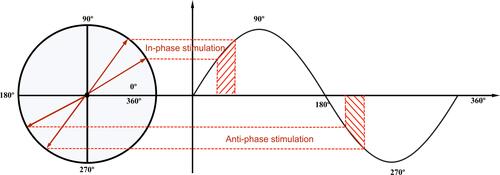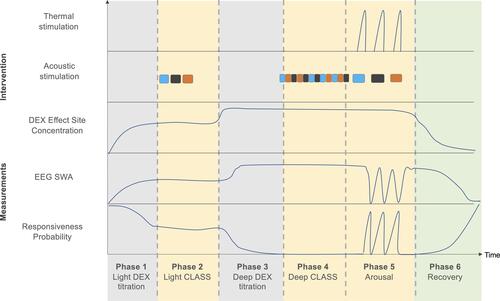Figures & data
Figure 1 Longitudinal study design. After being recruited, participants will be evaluated at the medical center. If they meet inclusion and exclusion criteria, they will be trained on how to use the Dreem device and record sleep EEG data prior to undergoing sedation. Participants will also record sleep EEG data on nights following sedation. A non-contrast structural brain magnetic resonance imaging (MRI) scan will then be completed at a later date.

Figure 2 Phase-locked acoustic stimulation. A circular plot can be used to visualize different phases of slow-waves that are targeted using phase-locked acoustic stimulation. In-phase stimulation delivers pink noise during the upslope of slow-waves, and anti-phase stimulation delivers pink noise during the downslope of slow-waves. In practice, acoustic stimulation is phase-locked to a range of the slow-wave’s cycle, represented in red here.

Table 1 Inclusion and Exclusion Criteria for CLASS-D
Table 2 CLASS-D Phases and Aims
Figure 3 Sedation protocol. The sedation protocol consists of six phases. In Phase I, dexmedetomidine will be escalated using TCI, causing a subsequent increase in SWA and impairments in the behavioral task. During Phase II, responsive participants showing EEG slow-waves will be presented with CLASS conditions while they are still performing the behavioral task. Upon entry into Phase III, dexmedetomidine will be further escalated to achieve loss of behavioral responsiveness. Phase IV represents the core of the experiment. Participants unresponsive and demonstrating EEG slow-waves will be presented with multiple blocks of CLASS conditions during a stable dexmedetomidine effect site concentration. Targeting of this dexmedetomidine concentration will be continued during Phase V. Participants will be aroused three times by thermal stimulation during CLASS. In Phase VI, the dexmedetomidine infusion will stop and resting EEG will be recorded as participants recover full responsiveness during the behavioral task. Blue, black and orange squares represent in-phase, antiphase and sham conditions, respectively. The order of CLASS conditions will be randomized across participants.

Figure 4 Decision tree during sedation protocol. In all cases, the sedation protocol will begin with the targeting of effect site and plasma dexmedetomidine concentrations of 2 ng/mL via TCI. In the event that slow-waves are not observed in the EEG, the target concentration will be increased in increments of 1 ng/mL to induce EEG slow-waves. If a participant with slow-waves continues to perform the behavioral task, they will proceed to light CLASS, after which the dexmedetomidine TCI is increased in increments of 1 ng/mL until they stop performing the task. This is followed by the deep CLASS, arousal, and recovery phases.

